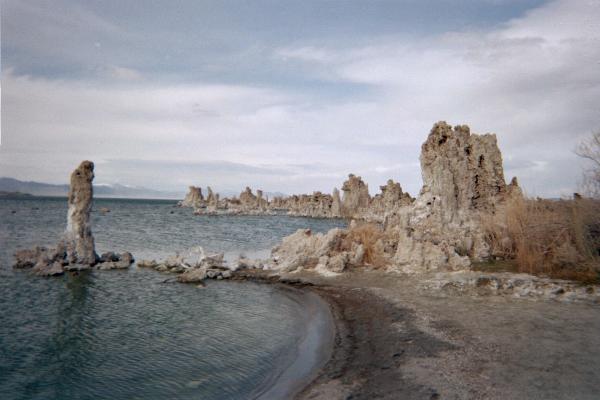
Of all the strange geologic formations found on the earth, the
tufa towers of Mono Lake are among the most bizarre. Tourists and
photographers travel from all over just to see these unusual
formations and experience the otherworldly landscape around the
lake. These rocky towers stand in clusters and alone, along the
shoreline of Mono Lake and breaking the surface of the lake near
the waters edge. They are each unique, asymmetrical spires reaching
heights of up to 30 feet tall. In 1981 The California legislature
established the Mono Lake Tufa State Reserve to help protect these
natural monuments.
Tufa towers resemble stalagmites rising from the floor of a
cave, partly because they are made of the same material: calcium
carbonate, also known as limestone. (also called dripstone, and
travertine) Unlike cave formations, however, these towers are not
formed from falling drops of mineral laden water, but from springs
of calcium rich fresh water that interact with the strongly
alkaline salt water of the lake as they flow upward through the
denser salt water. The chemical reaction that occurs under these
specific conditions causes the minerals to solidify and pile up at
a rate of up to an inch per year (scientists estimate the age of
the most recent Mono Lake tufa towers to be 200-900 years old).
Another thing that helps to build these towers is biogenesis – a
process in which one of Mono Lake’s primary residents, the Alkali
Fly, deposits calcium carbonate onto the forming towers. The fly
begins its life underwater, accumulating minerals in glands during
the larvae stage and leaving it behind when it emerges from its
pupae case.
Most tufa towers have a spongy-rock interior and a pipe-like
channel inside made by the spring. The towers grow underwater and
continue to increase in height until they reach the surface. When
viewed underwater, many are still active with fresh water emanating
from them. The rocky tufa towers are known as lithoid tufa,
referring to rock.
Mono Lake is one of the oldest lakes in North America, estimated
at about 700,000 to a million years old. It is fed by 5 streams, as
well as rain and snow, and has no outlet other than evaporation.
Over thousands of years, the salts and minerals that washed into
the lake accumulated until it became almost 3 times saltier than
the ocean and 80 times more alkaline. No fish can survive in the
lake but a specialized ecology has evolved which includes algea,
the alkali flies, brine shrimp, and over 80 species of birds which
nest on the central islands and among the tufa formations. Almost
90% of California Gulls were hatched at Mono Lake.
At the end of the last ice age, the lake was at least 5 times
larger than it is now and ancient Mono Lake tufa towers can be
found high above the modern lake level. In 1941, the water level
fell even more when 4 of the 5 incoming streams were diverted to
Southern California. The lake soon dropped to about half its
volume, doubling the salt concentration to its present 10%. This
sharp decrease in water endangered the fragile ecology that had
adapted to this unique environment over centuries. In recent years
this ecology has begun to stabilize as environmentalists have
worked to preserve the lake and raise the water level. The towers
we see on the shore are only visible because the level of the lake
has dropped, exposing them to the air, where they are subject to
physical and chemical weathering.
Tufa towers exist in several other places in the world where
conditions are exactly right for their formation, including
Greenland. There are tufa towers in other desert lakes in the Great
Basin, but Mono Lake has the most actively growing towers and is
also the most well known for their impressive natural beauty.